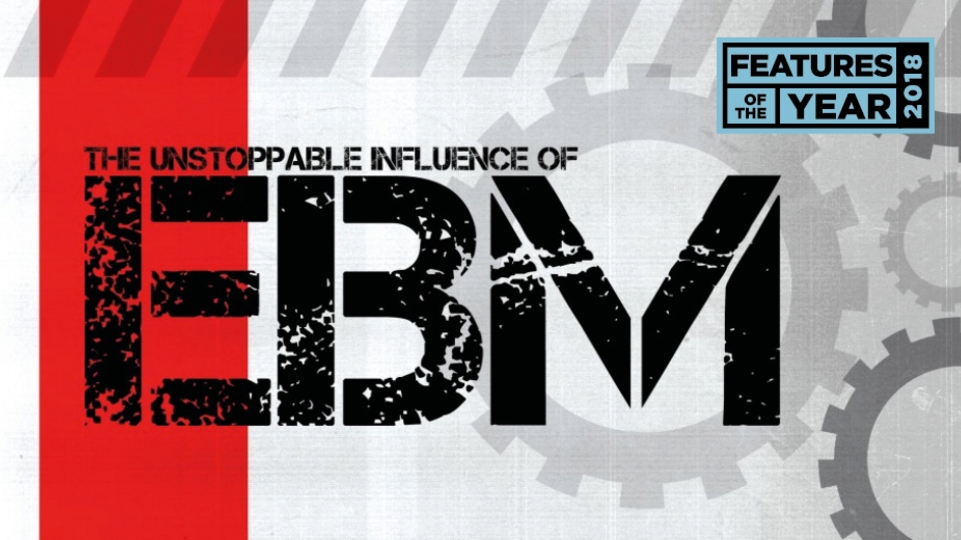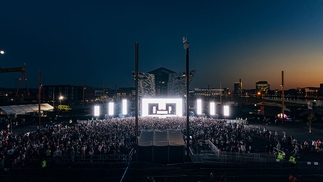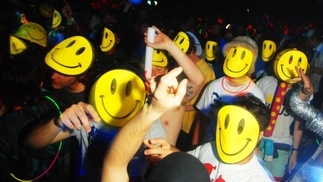The unstoppable influence of EBM

EBM has been simmering on the underground in recent years, and now DJs including Nina Kraviz and Helena Hauff are utilising the sound – alongside other music prefacing techno like electro – in their sets. Subsequently, the '80s movement largely swept away by acid house at the turn of the '90s is now back in full force. DJ Mag investigates the industrial dancefloor clatter...
Dance music has been alive with talk of the return of electro in recent months. And while long-time advocates of the scene including DJ Stingray, Dopplereffekt and I-F have seen a surge in bookings, flying the flag for the classic Detroit sound, many others – including Nina Kraviz and Helena Hauff – are finding increasingly widespread success combining techno and electro with the industrial clatter of electronic body music (EBM).
Aptly named, EBM is a full-on physical assault of pulsating basslines, syncopated beats, guttural synths, war-like noises and vocals that sit somewhere in the vastly unexplored space between shouting, rap and chanting, all blended with tropes of post-punk, industrial, dark synthpop and more in a melting pot of dystopian music designed to make you sweat.
"It's just fucking great dance music, and if you're in a club and the DJ mixes it in with other stuff, you're gonna dance," Helena Hauff smiles. "The return of EBM came earlier than the return of electro. But both genres never really went away. There were always music nerds in the underground keeping it alive, it just seems DJs playing on bigger dancefloors are more confident to mix a range of more challenging influences including EBM, as well as cold wave, darker synthpop, electro and more without losing the crowd."

Hauff often uses EBM in her wide-ranging DJ sets and has also used her Return To Disorder label to put out music by new artists producing the sound. "I feel like the term electronic body music is such a great name anyway because in music, for me, it's all about the energy, and when it comes to club music it's about the body. It's a very physical thing."
EARLY MANIFESTOS
The term was first coined by Ralf Hütter of Kraftwerk when talking about 'Die Mensch-Maschine' in 1978, to describe the album's more physical sound. However, the EBM movement truly started in the early '80s through artists such as Front 242 and Nitzer Ebb, their first recordings forming early manifestos for the genre. It gained wider recognition throughout the decade, predominantly in Belgium - alongside the new beat scene - and Germany, with seminal bands including A Split-Second, Signal Aout 42, Klinik and DAF raising the popularity of EBM globally.
Towards the end of the decade, its raw machine sounds, abrasive rhythms and driving basslines would play a huge part as a precursor for techno, solidified by Jeff Mills' work as one half of Final Cut - whose techno/industrial 1990 release 'Deep Into The Cut' leant heavily on EBM sensibilities - as well as his separate collaborations with members of American band Ministry. But by the early '90s, EBM in its original form had all but disappeared, eclipsed by the acid house revolution, with most of its original torch-bearers either disbanded or moved on to other forms of music - many such as Lassigue Bendthaus and Bigod 20 moving into making techno.

"EBM, early house and techno all have some degree of shared DNA," explains Bon Harris of seminal band Nitzer Ebb. "Each genre takes its own direction, but there are commonalities at source. The original EBM protagonists have had a resonant influence in a lot of genres. The aggression, energy and upfront danceability in the case of Nitzer Ebb are what seem to have captured a lot of imaginations."
While the impact of EBM has been clear to see in productions of techno artists such as Thomas P. Heckmann, Terence Fixmer, Adam X, Surgeon, Regis and many others through their careers, a new breed of EBM-influenced artists have been simmering in the underground for some time. Recently, there's been a vast increase in the number of artists, including Schwefelgelb, Silent Servant and Black Merlin, blending the sound with techno.
Elsewhere, Identified Patient has worked with vocalist Sophie du Palais on multiple releases to introduce classic snarling vocals to his EBM-infused techno, while acts like the now-defunct TENSE, as well as Sumerian Fleet, High-Functioning Flesh and Klack sound as if they could have been recording in the '80s without sounding remotely pastiche.

"The longer a style sticks around, the more respect it tends to get," Harris continues. "Especially if it holds up in terms of freshness and relevance. Patience is a virtue. If you can weather that intervening decade-and-a-half when you are completely unfashionable, it all comes back around. It is gratifying to feel that emotions and intentions that were important to us in formative years remain important to a new generation."
The Nitzer Ebb man is also excited that many of the new artists are taking the sound and tailoring it for modern day clubs. "It feels natural to me for EBM to be more dancefloor oriented," Harris explains. "That's where things started for us. Sure, we were interested in industrial imagery, but funk and soul have always been the heartbeat underneath a darker, harder sound. The funk is essential, it's what makes the music come alive, and gives it humanity - otherwise it's just a load of sequencers banging away."
MORPHING SOUND
While Artoffact Records has been repressing classic EBM albums due to the resurgence in interest in the sound, labels including Mannequin, Pinkman, Cititrax, L.I.E.S., Minimal Wave and the now-closed Jealous God have been central to the current boom in new EBM artists blossoming over the last few years. And the sound has started to morph recently, with tracks including IM KELLAR's 'IM KELLAR' and I Hate Models' 'Cyanure Dance' - both featuring high in DJ Mag's top tracks of 2017 year-end list - representing newer EBM sounds.

"Artists have more influences to draw from, an expanded range of tools and possibilities, and the vantage point of updating a classic style for modern times," Harris explains. "Artists like Rhys Fulber add another level of sophistication in the production. That's the advantage of taking a classic genre and using today's [technology], you can take it to another level."
Another key figure in this has been Alessandro Adriani, both as label head of Mannequin Records - with which he's released material from TENSE, JASSS, Raw Ambassador and Silent Servant through the imprint's 10-year history - as well as via his productions on EPs including 'Fall Elsewhere And Shatter', 'Tapes' and 'Guerrilla Warfare'.
"Techno was originally influenced by EBM, and between 1990 and 2000 producers were aware of what was going on before them in electronic music," Adriani explains. "But somehow over the years nobody spoke about that any more. Now, a lot of people have realised how much [EBM] influenced the last 20 years. I'm happy this happened, because for some time the two different sides have been watching each other. It was weird. If you played techno at a goth party in Berlin six years ago, they would kick you out the booth. I promise you," he laughs. "It happened to me!"

He also explains that the shift in sound on a wider scale is connected to the current political climate. "The music got more aggressive over the last few years with a comeback of noise and industrial," he continues. "It's less relaxed than the early '00s when we were more optimistic about the future. Now we have many negative inputs around us, and that's reflecting in the music. It's cathartic to sweat and express yourself now in a room full of bodies moving with energy."
A STATE OF MIND
New York-born, Berlin-based Phase Fatale, real name Hayden Payne, is another artist central to pushing the sound forward. Having come from a background of EBM, industrial and post-punk playing in bands since he was a teenager, Payne was one of the founders of the Fleisch collective label and event series in Berlin several years ago, who combined the heavier techno in the city with their vast knowledge of EBM.
"We reconnected the dots between techno and EBM, post-punk and industrial, which are the roots of techno anyway," Payne explains. "Over the last couple of years this sound has begun to enter the mainstream, to the point where DJs totally misinterpret what EBM is and just end up making shitty trance or electroclash. This is the same tragic fate EBM faced at the beginning of the '90s.
"But the true EBM scene never died," he continues. "Despite the trendiness of the word, there is and always has been great EBM and EBM-influenced music coming out of the underground. Some focus on fusing the sound with techno, adding a higher production value, especially in the low-end, or giving a bigger kick that is more suitable for dancefloors. Others, such as S English or Alvar, take a more industrial approach, focusing on extreme noise and sinister atmospheres. So, there is constant innovation in the genre.
"Many producers nowadays think it's enough to randomly set their sequencer to a chromatic eight or 16-step sequence and get it to play some hard-sounding synthesiser patch, add a snare drum on the two and four, and finish it off with some arbitrary vocals shouting about nothing. That's not EBM," Phase Fatale adds.
"To create an EBM bassline, which is one of the most distinctive elements of the genre, it requires a lot more than randomly fucking with your modular. There is a lot of precision and musicianship that goes into it, with carefully selected notes, syncopations, and space. Beyond that, EBM is more than just 'the sound'. It's a certain attitude and state of mind that most don't realise. EBM and industrial show the hideousness of society and culture, point out its absurdities, and laugh in its face.
“One must have an extreme and deep understanding and connection to this kind of music to know how it fuses with contemporary techno, and incorporate it into a DJ set without it sounding like a random mess. The range of people trying to play this sound is growing exponentially. But they actually have no clue about this music, and it's obvious to see. It sounds like EDM, not EBM."

Thomas P. Heckmann, who produced EBM-influenced techno in its first wave during the '90s, has seen something of a renaissance in his career recently, resurrecting his EBM alias Welt In Scherben for only the second time since the turn of the century with his 'Eisen Im Feuer' EP last year. The German DJ/producer is also set to re-release a selection of his early EBM-influenced tracks alongside remixes of contemporary artists including D Carbone and Codex Empire.
"I guess my tracks are not time-specific, and even though some are over 25-years-old, they still have the raw energy and sound that has lasted over the decades," Heckmann says of his music. "Even though some took time to be recognised, or even found, most of my music fortunately stood the test of time."
In March, Heckmann also drops a new album on Dax J's Monnom Black label. "It's called 'Body Music'," he explains. "As it's full of raw energy, broken beats, electro, acid and not only EBM stuff. Very much like techno was done in the '90s."

POSITIVE EDUCATION
The EBM resurgence is also clear to see in Amsterdam. DJ/producer and Artificial Dance label boss Interstellar Funk, real name Olf van Elden, is part of the Rush Hour Music team that are a large part of the scene, driving eclecticism in electronic music. They also distribute a number of labels pushing the EBM sound, including Mannequin and L.I.E.S.
"People in clubs are way more educated nowadays, and expect and want more," van Elden enthuses. "They're way more open-minded than they were five or 10 years ago. Then, people wanted to hear techno, and if you played something else, they didn't like it. Now people really come to the club to hear different kinds of music, genres and crossovers."
Interstellar Funk started his Artificial Dance label last year with Job Sifre's 'Worries', a release with two feet firmly placed in EBM. This year, the Amsterdam-based artist's Dekmantel podcast was a sublime selection of sounds surrounding the EBM resurgence, including music from Kris Baha and Identified Patient, while his 'Het Bestaan' EP is one of the strongest EBM-influenced releases of 2018 so far.

"It's not only EBM though," Sifre explains. "There's a comeback happening with a lot of genres on the raw end of the spectrum: post-punk, wave [sounds] and industrial are also back. That means that I can be freer when I DJ. At first, I was afraid I would scare people with my music, because it can be harsh. Now I see the rise of these genres, it's a lot easier to play whatever I want. Experimental music can also make it easier to completely lose yourself from daily life, which people are looking to do in fucked up times like these."
Fellow Dutchman David Vunk is part of another scene embracing EBM. As label boss of Moustache Records, an imprint more closely associated with darker Italo and synth sounds, his DJ sets mix EBM with new wave, no wave, Hi-NRG, electro, disco, darker synthpop and more. From Rotterdam, home of a number of artists influenced by EBM, including Das Ding and Alden Tyrell, Vunk is also one half of the duo behind 'IM KELLAR' - the EBM cut in our top tracks of 2017 - alongside David Spanish.

He says the rising popularity of more niche streaming platforms such as Intergalactic FM, Red Light Radio, Operator Radio and others helps push music that has existed on the fringes for some time, as well as the increasing love for eclecticism on dancefloors. "Taste is king now," he says. "Playing everything stops people from getting bored, so it's very trendy nowadays to play all the music you like in one set, and if you have good taste, you can mix it all."
Discodromo are also known for blending disparate-sounding influences into a cohesive message. February saw the release of their Artist Deleted 'Track Deleted (Discodromo Belgian Remix)' on Me Me Me, a track that combined the raw energy of EBM with proto-trance and new beat. They say that understanding the roots of the music you play can help string sounds together that may at first appear like they won't work in a mix.
"EBM is closely related to new beat," Giacomo Garavelloni of the duo explains. "And Italo can be considered the first cousin of new beat. Our DJ sets vary between styles and decades, and that's something that comes quite naturally."

He adds that the rise of EBM is connected to a saturation of sleek and over-produced techno in recent years. "That's created a need to return to a bolder, more melody-based and primitive sound," he explains.
NTS Radio's Elena Colombi is one of the UK's fastest rising selectors and leans heavily on EBM in her wide-reaching sets, as demonstrated in her recent DJ Mag Digital Recognise mix. She's clear why so many people love the sound again. "It's fast, hard, aggressive, pure and raw," Colombi enthuses. "While its energy is unique, and all about movement and sweat. It's very sexual too in a way. A total dancefloor workout. The machines used, the consciousness of the genre in itself. It's less of a movement, more of a statement. It's music that really makes your body move," she concludes. "If you can't dance to EBM, you're dead inside."





